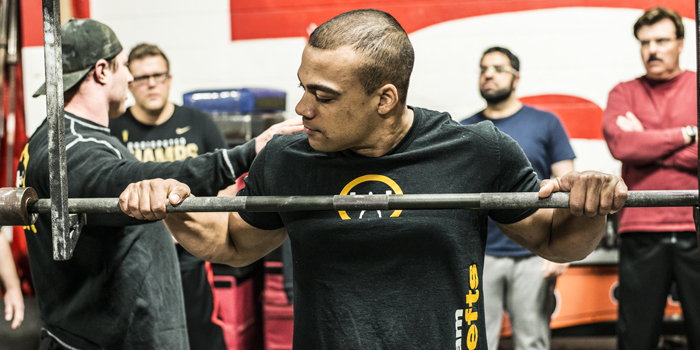
As a lifter ages, there need to be some changes in the way they train. What works best for someone in their early twenties will likely not be optimal for a lifter in their mid-forties. I find there are three key factors to consider as lifter’s age. Older lifters tend to:
- Need more recovery (this can take the form of reduced training frequency, exercise frequency, or more deloading)
- Be at an increased risk of injury (they have less robust tendons, ligaments and muscles)
- Have more out of the gym commitments (they have more demanding careers, they can have families as well as a multitude of other time constraints)
RECENT: 4 Big Errors of Beginner Strength Programs
In this analysis I’m going to compare an older and a younger lifter to examine some of the practical adjustments made in their training programs to accommodate for these factors. These are real lifters.
The Lifters
Tori
Age: 21
Gender: Female
Best Lifts: 352 Squat, 193 Bench Press, 365 Deadlift
Considerations: Tori is our young lifter. She is a former national and international level paddler. She has competed at an elite level in previous athletic endeavors. She has a very solid athletic base and at 21, her recovery is excellent. She’s a student with minimal life stresses outside the gym and can commit to a rigorous training schedule.
Grove
Age: 40+
Gender: Male
Best lifts: 450 Squat , 315 Bench Press, 550 Deadlift
Considerations: Grove is our mature lifter. First, he has a few major injury considerations. He has a shoulder injury that affects his bench press training and he has an ankle injury from an old motorcycle accident that makes single leg work like lunges and step ups very problematic. As a lifter in his forties, recovery has to be a concern. He also does some strongman training on Sundays for fun that has to be accounted for in his program. He has a wife and kids and owns his own business. These all contribute to a potentially large amount of lifestyle stress outside the gym.
Both lifters have the same goal, maximizing their powerlifting total. Both are equally invested in their sport, however there are some key differences in their programming that are influenced by the above considerations.
Older lifters tend to need more recovery for a variety of reasons. From the effects of aging muscles, bones and tendons/ligaments to dealing with a lifetime of wear and tear and/or existing injuries, to an increase in life stress outside the gym. These factors all contribute to some necessary changes in training. We’ll examine some of the practical differences here:
Frequency of Training
The first major difference between Grove and Tori was the frequency of training — both the number of training sessions per week (five for Tori and three for Grove, although his strongman Sunday essentially made this four) and the number of times per week each contest lift was practiced.
Tori’s program had her performing a variation of a squat or deadlift two to three times per week and a bench press variation three times while Grove maintained only a once per week squat and bench press frequency. Grove performed a deadlift variation two times per week because his primary goal was to increase his deadlift (aiming for 600) so he performed one main deadlift day and on his squat day he finished with lighter snatch grip block pulls.
Grove’s program also followed a strict three weeks of hard training to one week of deload to ensure recovery was being addressed. For Tori, she’s younger as well as being lighter and handling less absolute weight. As a younger lifter she has fewer recovery concerns and the lower magnitude of weight she lifts will induce less systemic damage. For her, a deload often represents a missed opportunity to train and make progress. Instead, she transitions from one block of training into the next without a planned light week.
Abbreviated Workouts and Auto-Regulation
The 80/20 rule has often been applied to lifting and I think it’s a great starting point to consider for a lot of older lifters. The premise is that 80% of your results are derived from 20% of your training. This concept has an influence on Grove’s programming. His training days are “abbreviated” to focus almost exclusively on the most important 20%, in this case a major compound exercise. The remaining 80% of training (supplemental and accessory work) is pretty minimal and relatively easy.
Here’s an excerpt from one of his training weeks. It’s very Spartan and you can see how most of the energy in each session is directed towards his primary lift for the day (bench + two-board on day one, squat on day two, deadlift + elevated deadlifts on day three). Any remaining exercises have a low recovery demand.
The goal with this is to get Grove to put his energy into the things that will produce the best results and consequently get the most “bang for his buck." This limits the total amount of work he does so he can still make progress without overtaxing his ability to recover.
Tori on the other hand doesn’t have the same concerns so she can train with multiple challenging exercises per day. This has her handling more work, more often. As long as she can recover she’ll see faster progress by training in this manner. Tori isn’t looking to get “the most for the least," she’s looking to get the most! So if she can do the extra 80% of the work it takes to get that last 20% of results, it benefits her to do so.
Here’s an excerpt from Tori’s training log. You can see that each day has greater amount of challenging work as compared to Grove’s training.
Grove’s program also employs a higher degree of auto-regulation. Basically the ability to adjust the training “by feel." As a business owner with a family (not to mention his strongman training sessions on Sunday) he has much more unpredictable life stress that could affect his training. In an attempt to compensate for this, his major exercises give him a range of sets and reps to complete. If he’s having a low stress week and is feeling good he can push towards the top end of the range. If he’s not feeling great, he can get the minimum in and get out.
Accommodating for Injury and Built-in Recovery Work
Another difference is Grove’s injury history. Limitations have to be taken into account. While this is a consideration for any lifter, masters lifters especially often come with old injuries and nagging issues that have to be worked around. In Grove’s case he has two major ones, a shoulder injury, and an ankle injury.
RECENT: The Mythos of Training Female Athletes
His shoulder often troubles him when he benches full ROM. Part of this is because he lacks the strength and mobility to keep his shoulders retracted in the bottom of the bench press. You’ll notice he has a “back circuit” on his bench day that focuses on a variety of shoulder retraction and external rotation drills to help correct this.
If he weren’t a competitor I would probably advise he avoid full ROM benching all together and work on his mobility, but since he is competing this isn’t a very practical solution. Instead, the work around is to have him do his warm-up sets to his chest to groove the motor pattern and then do his heavy work off a two-board. The extra couple inches allows him to keep his shoulders in a better position and he can press without pain.
His ankle injury doesn’t limit him too much for powerlifting but makes unilateral movements very difficult. This means single leg work like step ups, lunges and split squats are off the table. This isn’t a big deal since unilateral work isn’t a huge component of most powerlifting programs. However, if in the future we want to work on structural balance or need to address a weakness we’ll have to get creative with the exercises we do.
As a restorative measure, Grove's program also includes plenty of reverse hypers to help keep his back fresh.
Conclusions
Being a more “seasoned” lifter doesn’t mean it’s all over and you can’t still make progress, but you’ll likely need to make some adjustments compared to what the younger folks are doing in order to optimize training to your own needs. Hopefully these examples give you some ideas on how to go about it.









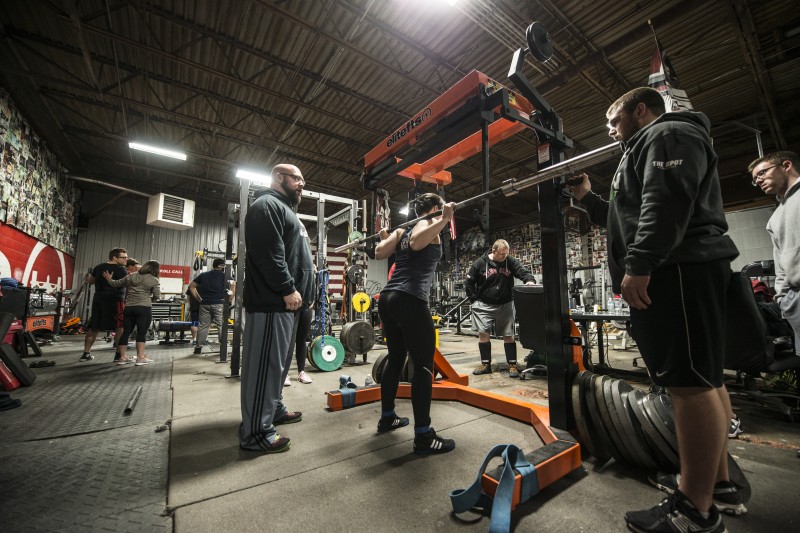
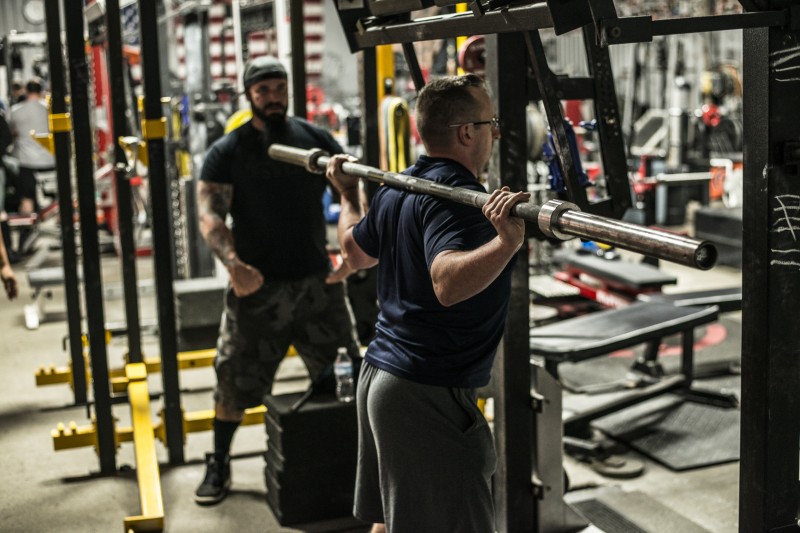
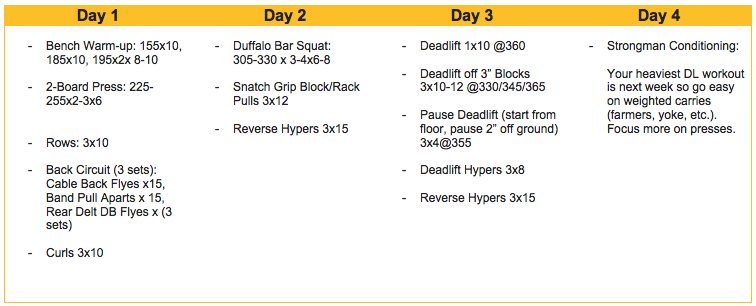
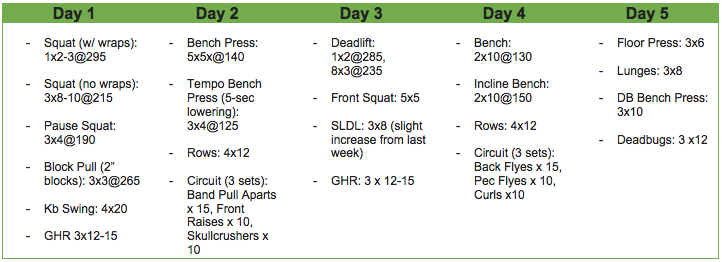

Thank you for the article and keeping us forgotten older lifters in mind.
Jonny